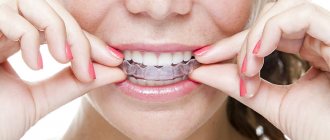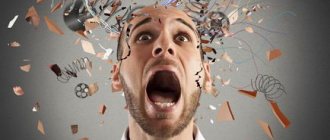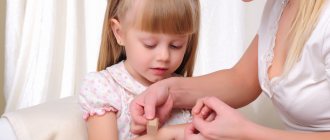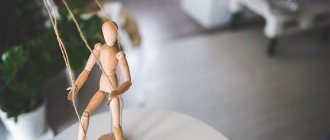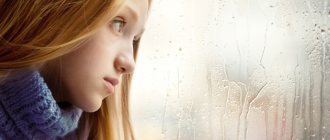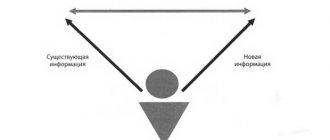- Causes
- Help for children
- Children under 3 years old
- Children 4-6 years old
- Children 7-13 years old
- Children over 13 years old
- Problem in adults
The child cannot control himself: twirling curls around his finger occurs on a subconscious level. The psychology behind the habit of twirling one's hair on one's finger indicates a nervous disorder and is a common problem among children. The child cannot control himself: twirling curls around his finger occurs on a subconscious level. For some children, this is a way to take their mind off their worries.
This mental disorder is common among girls who have long hair. Treatment depends on the severity of the disease and the age of the child. It is better to seek help from a specialist.
Causes
The most common reason is habit. A person twirls his hair at a moment of thoughtfulness, awareness of some problem, or prolonged reflection. This simple action helps you concentrate on your thoughts and stop reacting to external stimuli.
Other reasons are presented below.
- The desire to calm down. The sensation of twisting your hair is reminiscent of a soothing pat on the head or a relaxing massage. That's why children of preschool and primary school age can use this relaxation method. Sometimes it’s easier to cope with separation from your mother.
- Fall asleep faster. The baby plays with his hair when he falls asleep. Gradually he falls asleep without the help of his parents. Usually this bad habit is eradicated with age.
- The desire to escape from your problems. As a child gets older, the number of stressful situations increases. The habit of touching hair develops into a compulsive action. A vicious circle is formed: he gets a little nervous - he twirls his hair - he realizes that this is bad - he gets nervous.
- Another reason is a feeling of defenselessness. Being very frightened, the baby decides to pull his hair. He thinks that this will make the situation safer and help get rid of obsessive fear.
- It happens that he begins to pull not only his own hair, but also other people’s. This is how a child often hurts his mother without even realizing it. Sometimes he uses his fingernails, literally tearing out entire clumps of hair. And there is only one explanation for this - he is scared and wants his parent to protect him from everyone.
Comb your hair intensively, use rough combs
The beauty of our curls requires the most gentle treatment, especially with thin hair, which is already easily damaged. When combing your hair, do it slowly and carefully. There is no need to rush in this matter, otherwise you will simply tear the strands. It is important not only how, but also with what you comb your curls: plastic, metal combs with sharp teeth are a direct path to thinning them.
Look for massage combs or brushes made of wood and natural bristles. Pay attention to the cloves: they should not be too frequent, sharp, or jagged. Such combs damage not only the hair structure, but also the scalp: they can cause micro-scratches.
The Tangle Teezer comb is very popular. It has soft teeth and can be used to comb even wet hair. It is also recommended for thinning and split ends of hair that breaks when using a traditional comb.
Symptoms
The compulsive action is so important that the inability to perform it is perceived as a threat to life. The need to constantly pull your hair occurs in stressful situations and is repeated. This may also be a reaction to chronic stress that the child cannot eliminate from his life (parental quarrels, peer bullying, problems at school).
If an uncontrollable action is interrupted, the child will do his best to look for a way to complete it: he will begin to twirl his hair a certain number of times or in some sequence. The baby will do this until he calms down completely.
Checklist: what to do if you touch your lips, nose or eyes
- Don't scold yourself - this will not achieve anything except unnecessary stress. On the contrary, you did well: you tracked the touch in time and are ready to take precautions.
- Wipe your hands and face with a damp cloth or antiseptic gel to cleanse your skin of viruses.
- Identify the reason why you made the “forbidden move.” What is this - an unconscious gesture, a habit or a consequence of some inconvenience?
- Try to eliminate the irritant that makes you touch your face. Watch your movements carefully so as not to repeat this gesture.
Take care of yourself and be healthy!
Remember, our well-being depends on ourselves!
Consequences
Any neurosis that is not diagnosed and treated in a timely manner significantly harms the child. The psyche at this age (preschool and primary school) is still fully formed, and the nervous system is unstable.
A lot of physical and mental energy is spent on compulsive action and thoughts about it. As a result, obsessive curling of curls in children can lead to the following consequences:
- decreased capabilities of all cognitive processes (memory, attention, thinking);
- the child gets tired quickly and is unable to concentrate on lessons;
- sleep disorders, nightmares;
- lack of contact with other children (he does not play, does not make friends with them, because they can tease him);
- general isolation, lack of contact with adults.
Hair follicles suffer from constant tension. As a result, the hair breaks, becomes dry, lifeless and falls out. In damaged areas, curls may not grow back well for the rest of your life.
The worst thing is if the baby starts pulling out hair on his head.
This occurs when a child begins to twirl their hair around their thumb. This habit can eventually develop into trichotillomania. This is a type of auto-aggression when, in order to calm down, a person pulls out individual hairs or even tufts of hair on the body. In neglected situations, bald patches form. In such a situation it is no longer possible to cope without the help of a psychiatrist.
Tamara (shpilki.net)
Lena Posted 04/19/2017
Hello, Lena. In children, curling hair on a finger is a primary sign of neurotic disorders that arise against the background of deprivation from the mother (in other words, separation and lack of maternal love) or as a defensive reaction of the child’s psyche to sudden changes (in the family, place of residence, etc.). This problem is not an aesthetic one, so you need to seek advice from a child psychologist. A specialist will be able to identify the causes of the problem and, using specially selected techniques, help your daughter cope with uncertainty and fears. Do not delay with therapy; it will be more difficult to treat during the school period.
Answer
Text \ Photo Ekaterina Posted 05/28/2015
+5
share:
To favorites
To print
If you want to thank, add clarification or objection to the author - add a comment!
Currently being discussed:
- Lyubov Burkina
20.08.2018
What hair color should I choose? Please give me some advice. I don't know which one I have...
- I
19.08.2018
I had eyelash extensions for 6 months and took a break. After 3 months I increased it again...
- Vasilisa
18.08.2018
Cool hairstyle
18.08.2018
Hi, can I dye my bleached hair (currently red) bright purple...
16.08.2018
Hello! I am a dark girl with black eyes. I want to dye my hair dark...
15.08.2018
The photo shows young beauties. Can older ladies have their eyebrows done? Age...
Comments »
Self-medication
Helping a child or even an adult on your own is possible. Especially if a girl or teenager suffers from this bad habit.
Some of the simplest but most effective methods are:
- creating beautiful hairstyles;
- braiding;
- beautiful hair curling;
- gentle and neat styling;
- short haircut (if it suits your face), etc.
The girl needs to be explained that pulling her hair is an indicator of her excitement and worry. That this does not always look attractive, and characterizes a person as nervous. It is necessary to delicately and very carefully explain to her that such similar actions make her image one-sided and demonstrate her as a complex, insecure person.
Some doctors advise patients to take up handicrafts. Hands will always be busy, and a person will have no time for curling curls. If the activity is really exciting, then getting rid of the problem will be easy.
Help for children
Having noticed signs of abnormal behavior in time, parents can help the child themselves. The nature of the actions depends on the age of the baby.
Children under 3 years old
There is no need to hit their hands when they twirl their hair. This will worsen the relationship between the baby and parents, but will not help eliminate the bad habit. In books on child psychology they write: if mom and dad focus on the child’s problematic behavior, he may deliberately commit provocative actions.
Treatment options
The first step on the path to recovery is a consultation with a psychologist. It helps to find out the reasons for the development of such a habit. It will explain whether it is an addiction or just an alarming symptom.
If it's just a habit, a behavioral approach will do. In psychology, this is one of the methods of behavior management. You need to make sure that curling your hair leads to unpleasant consequences (not to punishment, but to not getting what you want). A short haircut helps, but only with the consent of the child.
If we are talking about compulsive actions or auto-aggression, you need to perform the following steps.
- Continue working with a psychologist until complete recovery or a significant reduction in the severity of symptoms.
- Drug treatment can be included.
- It is important to follow a daily routine. Do certain things on a clear schedule day after day (sleep, eat, walk). This routine is calming, because you know in advance what will happen and when. The nervous system receives a resource to overcome the disease.
Development occurs from a “point of rest,” that is, at a time when there are no shocks in life.
When curling your hair, there is no need to pull it back or make comments. This will push your child away from you and cause him to hide.
Calmly ask what is bothering the child. Try to discuss everything and show another way to calm down. The best thing to do is to hug him and tell him that he is the most wonderful and loved one.
Use your example to show how you can deal with anxiety, anger and irritation constructively. Not by swearing and screaming, but by expressing your emotions in the form of “I” messages. Phrases used in the process:
“I’m upset because...”; “I’m offended because...”; “I’m very glad, because...”, etc. Talk about feelings on your own behalf, meaning the baby’s experiences. The child must understand that he is not alone, he has support.
The most difficult thing in psychotherapy is to find out that parents themselves provoke the formation of stress. You need to be prepared for this, do everything in the interests of the family member.
During the period of therapy, there should be no scandals, major holidays, moves, or changes of schools in the family. Stress, both positive and negative, is detrimental in such situations.
How to stop consciously touching your face
So, you've made a list of situations where you touched your nose, lips or eyes. Analyze these moments: highlight gestures that were conscious and purposeful. Now determine what made you bring your hand to your face - this will help you understand how to get rid of these unwanted provoking factors.
Hair gets into your face
An unruly strand keeps falling over your eyes and tickling your cheek. You put it behind your ear, but this only helps for a while. To get rid of such an irritant, gather your hair in a ponytail, bun or tight braid. Secure unruly curls with bobby pins or fix them with hairspray.
Need to fix my makeup
Any makeup, even perfectly applied, sometimes needs adjustment. To avoid having to correct leaking eye shadow, mascara or lipstick, use long-lasting cosmetics that last all day. Another option is to completely abandon makeup during the COVID-19 pandemic. After all, it’s hard to see the beauty of your new lipstick or the shine of your highlighter under a medical mask.
Another trick is to put on bright, fashionable makeup so that you simply “don’t raise your hands” to touch your face. Every time you want to rub your eyes or lips, you will remember how you applied foundation, blush, eye shadow and mascara. Is it possible to touch all this beauty?
Beards and mustaches cause irritation and itching
Many men face this problem. Some people note severe irritation on the skin when a beard or mustache is just growing. Others experience discomfort due to long hair that curls and pushes against the skin.
During the COVID-19 pandemic, men are recommended to shave their mustaches and beards. After all, if there is no facial hair, you will be less likely to touch your lips, cheeks and nose. In addition, it is more difficult for those with a mustache and beard to put on a medical mask correctly - so that it fits tightly around the face.
Eyes get tired and dry
Dry eye syndrome is a long-term disruption of the integrity of the tear film that covers the cornea and conjunctiva of the eye. With this pathology, the eyes turn red, itching, burning, and a feeling of “sand” appear under the eyelids. Dry eye syndrome develops for various reasons:
- long work at the monitor;
- staying in a room with dry, air-conditioned air;
- some diseases (diabetes mellitus, hepatitis, hormonal dysfunction);
- side effects from taking medications;
- use of unsuitable contact lenses or solutions for their care;
- violation of the rules for using contact lenses, etc.
When the first symptoms of dry eye syndrome appear, consult a specialist to identify the cause of the disease. If you wear contact lenses, be sure to follow the rules for caring for them: rinse them thoroughly with a special solution, remove and put them on only with clean hands, and replace them regularly with new ones.
To prevent dry eye syndrome, it is recommended to use moisturizing eye drops, take breaks when working with gadgets for long periods of time, and do not neglect visual exercises.
If you spend a lot of time in front of a computer monitor, try switching to Bausch+Lomb ULTRA® monthly silicone hydrogel lenses. They ensure eye comfort is maintained even when working with digital devices for long periods of time.45
Never rub your sore or itchy eyes. This will only increase irritation and risk introducing infection into your eye, including COVID-19. Better wash your hands with soap, remove your lenses (if you wear them), and put special moisturizing drops into your eyes.
Cognitive behavioral therapy
This technique is effective in relation to both an adult and a child. The goal of cognitive behavioral therapy is to change the patient's negative attitude to a positive one. As a result, he should understand that he can calm down or get out of a state of stress without curling his hair.
At the beginning of the first session, the psychologist must find out the reasons for the development of OCD. To do this, he asks the client to share thoughts about the following:
- does he feel better from tugging at his curls?
- how he feels when he pulls his hair;
- does this action bring him pleasure, peace and tranquility;
- what will happen if he stops doing this;
- does he understand the consequences of this bad habit, etc.
In addition to an individual conversation, the patient must do homework. The speed of healing depends on the quality of their execution. They mean studying materials about the dangers of pulling hair: watching video lectures, reading specialized literature, communicating with trichologists.
The average duration of treatment is 5-6 sessions. They last 40-60 minutes and take place once a week. If the habit has already reached the stage of mental dependence, then the duration of the course can be 10 lessons.
Signs: finding hair in food, drink
It is very unpleasant when hair comes across during a meal. However, this incident is worth paying special attention to, since it is a harbinger of a more significant event that can affect life in general.
- If the hair ended up in your mouth before it was noticed on the plate, then you need to watch your statements. Otherwise, a careless word can lead to a scandal with neighbors, friends or relatives. People around you should tell as little as possible about your personal life.
- To dream that there is a hair in food foreshadows many troubles and misfortunes. To achieve the goal you have set for yourself, you will have to try hard and overcome many obstacles, according to the signs.
- Seeing it in a plate of food while eating means joyful events, happy moments, favorable changes in life. The longer it is, the more happiness awaits the finder.
- Finding lint in a cup of drink means guests will arrive from afar. Moreover, guests will bring with them fun to the house, good news and good mood.
- If you find a hair in a dish that was prepared without anyone’s help, and its color and length clearly indicate that it belongs to another person, then this promises problems in your personal life, quarrels with family members, and troubles at work.
- The discovered lint is smooth and straight - the existing troubles will come to an end. Life will become calm and measured. If it is curly, then something bad will soon happen that will bring sadness and tears into life.
- If it has a light color, it is a good omen, foreshadowing the restoration of relations with a person with whom the conflict has been going on for a very long time. Black color - ill-wishers want to do some kind of dirty trick that will negatively affect work activity. Brown - you should not make hasty decisions, as they will turn out to be wrong. Gray - a loved one will unexpectedly give a gift for no reason.
- Finding very short hair in food is a bad omen, promising financial problems and lack of money. Too long - means traveling to distant lands or a long-term illness from which it will be difficult to recover.
- Hair is constantly found in food - a good sign, promising unexpected large profits, as well as great love that will last until the end of life. But this is the case if they are light, and dark ones, according to signs, on the contrary, foreshadow monetary losses and quarrels with a loved one.
Related article: Why did a cat shit on the bed - signs However, hair can also be found on clothes, which indicates that life will be filled with pleasant surprises.
Group therapy
This technique is not used with children, only with adults. The group usually consists of 10 people who are united either by common symptoms or by a common reason for the development of this bad habit.
All participants sit in a circle and begin to share their stories. This is the stage of acquaintance, the purpose of which is to position all patients towards each other in order to build constructive dialogues, because sometimes people with the habit of pulling their hair are antisocial.
Role-playing games may be carried out. The most popular is wish fulfillment if one of the patients starts doing these obsessive actions again.
Lectures are also provided during group classes. Their goal is to show a person that the habit of pulling one’s hair does not bring anything good, and it is better to get rid of it.
Group classes in various types of physical activity are possible: yoga, meditation, aerobics. The conversation participants also attend cultural events and communicate a lot with trichologists.
Art therapy
When communicating with children, such a conversation may not give the expected results, so it is easier to find out the causes and symptoms with the help of art therapy. She means depicting her problem using different types of art:
- drawing;
- theatrical action;
- singing;
- dancing;
- handicrafts, etc.
It is important to choose the activity that your baby loves most. Then he will not feel any tension when communicating with the doctor.
Visual art therapy is commonly used. The psychologist communicates with the baby, and he draws in the process. The doctor asks you to depict what is bothering him. There are no restrictions.
After this, the baby’s creation is evaluated. All lines, strokes, and ornaments are taken into account. Of particular importance is the color scheme, which makes it possible to assess the stage of the disease.
Next, the doctor asks the child to destroy his drawing in any way - tear it, trample it, wet it with water, etc. The main thing is to get rid of the image, and with it the problem.
How to stop unconsciously touching your face
Getting rid of unconscious gestures is more difficult than conscious ones. Often we simply don't notice them. Or we catch ourselves making a “forbidden movement” (scratching our nose, rubbing our eyes, touching our lips) after we have removed our hand from our face.
To get rid of such gestures, you need to organize your life so that you do not want to touch your nose, lips and eyes. Or that you simply do not have such an opportunity.
You rest your chin or cheek on your hand
This position may be comfortable for working at a computer, but during the COVID-19 pandemic, such positions are best avoided. To do this, make your workplace as comfortable as possible: buy a chair with an ergonomic back and armrests, and place the monitor strictly at eye level. Then you simply don’t want to reach your hand to your face - it will be more convenient to lean back in the chair and put your hands on the armrests.
You often rub your face because your skin feels dry
Dry, itchy, tight skin feels like it's asking to be rubbed or scratched. An integrated approach is needed here: the skin should be regularly moisturized with cream, and hands should be kept away from the cheeks and nose. Twice a day - morning and evening - apply them to your face, remembering to wash and disinfect your hands before doing so.
Bad habits
Rubbing your nose, biting hangnails, scratching your head, twirling a strand of hair around your finger - these are just a few of the habits that you should get rid of. Often behind a bad habit there is some kind of emotion that a person may not be aware of. For example, some people bite their nails when they are nervous.
You can get rid of bad habits on your own or with the help of a psychologist. It will teach you to notice stress and respond to it in a safer way.

